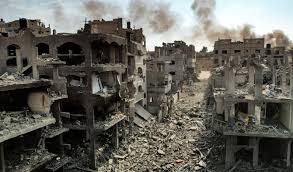
By Joschka Fischer
With Iran’s drone and missile attack on Israel on the night of April 13, the war in the Middle East has taken on a new dimension. For years, the conflict between Iran and Israel had been a “shadow war” in which both sides avoided direct military strikes on each other’s territory. Instead, the conflict reached furtively into the streets of Tehran, where there have been assassinations of Iranian nuclear scientists and engineers, and into war-torn areas of Syria, Lebanon, Yemen, and Gaza. In those hot spots, the so-called Axis of Resistance – comprising Hezbollah (in Lebanon), Hamas (in Gaza), and the Houthis (in Yemen) – receives extensive support in the form of Iranian money, weapons, and training.
The current war started on Oct. 7, 2023, when Hamas launched an attack on Israel that claimed 1,200 lives and 253 hostages. Israel soon hit back, and the war has been raging in Gaza ever since. As a result of the Israel Defense Forces’ campaign to eliminate Hamas once and for all, more than 30,000 Palestinians have been killed, and the enclave has been laid to waste.
Despite these horrors and the appalling conditions in Gaza, the war is the latest chapter in a bloody conflict that Israelis and Palestinians have been fighting over the same stretch of land for almost 80 years. By contrast, Iran’s direct attack against Israel represents something new. To launch a strike from Iranian territory, rather than operating through proxies, is to invite retaliation against Iran itself. The Iranian regime either must feel very sure of itself, or is under enormous pressure to make a show of strength, even if that means risking “open war” not only with Israel but also with the United States.
The immediate trigger was Israel’s April 1 strike on an Iranian consulate building next to Iran’s embassy in Damascus, where several members of the Iranian Revolutionary Guard Corps, including two high-ranking commanders, were killed. Though these were hardly the first casualties of Iran’s “shadow war” in Syria and Lebanon, the Iranian leadership nonetheless felt compelled to respond.
True, Iran did reportedly let the US know through informal channels that its counterattack was imminent, and no one was particularly surprised when it came. Nonetheless, the implications of the move are profound. The war is no longer an Israeli-Palestinian one over the same stretch of land; it has been regionalized – even globalized.
Looming ominously in the background is the potential threat posed by the Iranian nuclear program. Given the latest developments, this existential threat to Israel is becoming less hypothetical by the day. Will Iran take the final steps to cross the nuclear threshold, and does the mere possibility increase the odds of a war with Israel and the U.S.? That is now the big question for the entire region.
Moreover, we know that Iran’s aims extend beyond achieving regional predominance. The regime would welcome the replacement of the U.S.-led international order by a more multipolar system in which great and emerging powers compete. To command a powerful position in this new international order will require nuclear weapons, access to state-of-the-art technology, and an end to the economic isolation implied by far-reaching Western sanctions. All this now looks to be within reach through its deepening ties with China, Russia, and parts of the Global South.
Iran’s theocrats know that they are in a fraught position domestically. Large-scale protests led by women, young people, and ethnic minorities (in Kurdistan and Baluchistan, for example) have discredited the regime, as has rampant corruption among the ruling elite. The country’s aging leadership no longer has any legitimacy; it is merely surviving through outright repression. But while relying on truncheons and bullets may work for a while, it is hardly a recipe for long-term success.
In geopolitical terms, however, the situation is completely different. Iran’s theocratic regime is among the big winners of the transition away from the U.S.-led world order. According to the International Atomic Energy Agency, Iran’s nuclear program has advanced further than ever, putting it on the threshold of enriching enough weapons-grade uranium for a bomb. One also should assume that Iran has the technological know-how to build a nuclear warhead and the systems for delivering it.
In an increasingly favorable geopolitical landscape, Iran’s marriage of convenience with Russia and China is of paramount importance, not least because it will allow the regime to escape its decades-long international isolation. As new and emerging powers seek to develop new multilateral structures beyond the reach of Western hegemony, Iran will almost inevitably benefit.
The war in the Middle East must be understood in this broader context, which also includes Ukraine and Taiwan. We are witnessing increasingly bold and ambitious efforts to topple the old Western-led order through any means necessary – even outright war. Joschka Fischer, Germany’s foreign minister and vice chancellor from 1998 to 2005, was a leader of the German Green Party for almost 20 years. This article was distributed by Project Syndicate.(Curtsy: Korea Times)
Disclaimer: The views and opinions expressed in this article are those of the author and do not necessarily reflect the position of The World News AM


